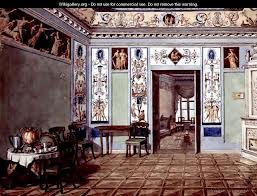In the year 79 A.D. Mount Vesuvius, a volcano near the bay of Naples in Italy, erupted and the ancient Roman city of Pompeii was buried under its volcanic ash. At least 2000 people were trapped and had no choice but to accept their imminent fate. 1699 years after the eruption, in the year 1748 B.C., Pompeii was rediscovered. It was found that under the thick layer of dust and debris Pompeii was mostly intact. Here are 10 interesting facts about Pompeii.
#1 FIORELLI WAS BEHIND RECREATING THE FORMS OF VICTIMS AT POMPEII
In 1860 Giuseppe Fiorelli took charge of the excavations of Pompeii. During early excavations certain voids were noticed which contained human remains. It was Fiorelli who realized the reason behind these voids – the volcanic material had covered the bodies of the dead, setting hard and solid around them and as the body and clothing decayed, a void was left. This void represented the exact shape of the corpse at the point of death. So Fiorelli devised the technique of injecting plaster into the voids to recreate the forms of the victims of the tragedy.

#2 THE CAST OF THE DOG AT POMPEII IS VERY FAMOUS
The recreation of the victims of the eruption of Mount Vesuvius is one of the major reasons for the popularity of this ancient site. People are moved by the sight of these plaster people clinging to each other as the catastrophe approached, mothers cradling their children, husbands embracing wives. And not just humans – one of the most famous of the remains is the cast of a dog who is chained and making a futile attempt to escape.

#3 POMPEII IS CALLED THE ‘CITY OF THE DEAD’
Pompeii is often called the “city of the dead”. This term to describe Pompeii was first used by novelist Sir Walter Scott who constantly muttered these words as he was carried round the excavation on a sedan chair.

#4 THE ERUPTION OF MOUNT VESUVIUS WAS ‘PLINIAN’
The eruption of Mount Vesuvius was unusual without lava and other characteristics associated with volcanoes. It involved superheated gas and volcanic ash extending high into the air. The pulverized rock then poured down and swallowed everything and everyone in its path. Pliny the Younger provided a first-hand account of the eruption 25 years later. At the time of eruption he was positioned across the Bay of Naples at Misenum. His uncle Pliny the Elder died while attempting to rescue victims. Similar eruptions are called ‘Plinian’ by volcanologists as recognition to the account of the event given by Pliny the Younger.
#5 It WAS DISCOVERED BEFORE BUT IT NEVER CAME OUT
A few parts of Pompeii were in fact discovered before the eventual excavations that started in 1748. In 1599 while digging an underground channel, walls covered with paintings and inscriptions were unearthed. The architect Domenico Fontana unearthed a few more frescoes but covered them over again and Pompeii remained unknown. There are a few theories about Fontana’s act of covering over the paintings. The most prevalent is that Fontana found some of the famous erotic frescoes and he reburied them as an act of censorship or for preservation for later times.
#6 THE SECRET CABINET OF POMPEII
Apart from frescoes even many recovered household items in the excavations had a sexual theme. The presence of such imagery and items indicate that the ancient Roman culture was more liberal than most present day cultures. This clash of cultures led to many discoveries in Pompeii being hidden away again. In 1819, when King Francis I of Naples visited the Pompeii exhibition with his wife and daughter, he was so embarrassed by the erotic artwork that he decided to have it locked away in a secret cabinet, accessible only to “people of mature age and respected morals”. Re-opened, closed, re-opened again and then closed again for nearly 100 years, it was finally re-opened for viewing in the year 2000. Minors still need to be accompanied by a guardian or have a written permission, to enter this once secret cabinet.
#7 ONE CAN HAVE A PEEK AT ANCIENT ROMAN LIFE AT THE SITE
Pompeii provides a snapshot of ancient Roman life. Pompeii had several small restaurants, baths, a mill, a food market, a hotel, a sort of a bar serving cold and hot beverages, an amphitheater and two theatres and an aqueduct that provided water for street fountains, baths, houses and businesses. There was also a brothel with the names of the women who worked there, their “special talents” to please their clients, and prices of services etched on its walls.

#8 ITS DISCOVERY STARTED VARIOUS TRENDS
Many scholars believe that the excavation of Pompeii played a major role in the neo-classical revival of the 18th century. Wealthy and fashionable families of Europe displayed art and reproductions of objects from the ruins. Pompeii’s buildings also shaped the architectural trends of the era. For example, wealthy British families often built “Etruscan rooms” that were like those in the villas of Pompeii.
#9 POMPEII IS A WORLD HERITAGE SITE
Pompeii was declared a World Heritage Site by UNESCO in 1997. It has been a popular tourist destination for 250 years. It is visited by approximately 2.5 million people every year.
#10 IT NEEDS $335 MILLION TO STAY PRESERVED
The objects buried underneath the ancient city were preserved for almost 2000 years but after being unearthed, natural and man-made forces have led to their decline. This has concerned archaeologists and Pompeii was included in the 1996 World Monuments Watch by the World Monuments Fund, and again in 1998 and in 2000. It has been estimated that $335 million are needed for the conservation of the site.






horrible
i learned a few things
Hello. And Bye.
wow, nice things lots of help!!! 🙂
it did help alot